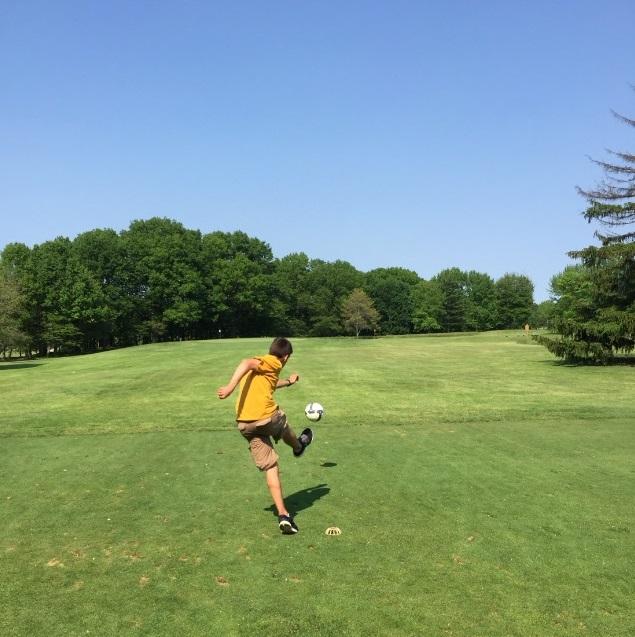Fusion sport finds footing in US
August 7, 2015
People have been pulling out their drivers to tee off on the golf course for centuries, while soccer players have been striking the ball into a goal for even longer. But only as of 2008 did these two popular sports fuse together, when a group of professional soccer players in Holland organized the first footgolf tournament on record.
The object of footgolf, which is played along the holes of a golf course, is rather simple, as players attempt to kick a soccer ball from a tee box into a hole in as few kicks as possible. Instead of using a set of golf clubs to advance the ball into the hole, all players need are their feet to kick a size five, regulation soccer ball down the fairway.
Since this sport is very new, there aren’t many footgolf courses in the country. According to the United States FootGolf Association (USFGA), which is the largest footgolf governing body in the country, there are only about 400 golf courses with footgolf holes offered of the 16,000 total golf courses in the nation today.
While the opportunities for footgolf are quite scarce currently, this scarcity does not mean the sport doesn’t have a growing popularity, says Dan Kapsalis, President and Co-founder of USFGA. Shawnee Hills and Mastick Woods golf courses of the Cleveland Metroparks are the two nearest courses with footgolf.
“Footgolf is just beginning in this country, but it is without a doubt growing very quickly,” Kapsalis said. “This sport appeals to everyday golf courses, which will allow it to become more popular in the coming years.”
One of the missions of USFGA is to work with several golf courses across the country to help them integrate footgolf with their golf programs.
“We’ve noticed that a lot of golf courses are struggling to keep up business since there are more courses out there than there are golfers to play on them.” Kapsalis said. “Courses benefit tremendously from adding footgolf just because it gets more people onto the property.”
However, golf courses aren’t always convinced it’s worth it. Carlos Stremi, a member of the USFGA Executive Board and President of the Illinois Footgolf Association, says that they try to convince the courses that attracting a new crowd makes it worthwhile.
“Our main selling point to golf courses is that they’re tapping into a new audience,” Stremi said. “Courses will have more people on their property since it will be exposed to a new demographic that would have never come to the golf course in the past.”
The Ohio Footgolf Association also stated that “footgolf may very well become the best second income opportunity available for the [golf course] industry today.”
It doesn’t take a whole lot for golf courses to add footgolf. In fact, it doesn’t even require more land since it can be played on the same holes that are normally used for golf. All a course would need to do is to simply add holes (big enough for a soccer ball) along the course.
Unless Cristiano Ronaldo is the one “kicking off” on a footgolf course, most players can’t kick nearly as a far they could drive a golf ball, so the holes are much shorter. An entire 18-hole footgolf course can fit within just 9 golf holes at most courses. Footgolf holes are not on the golf greens and footgolfers don’t wear cleats, so golf courses aren’t damaged.
In October of 2015, the first ever national footgolf tournament will be played at the Rockwood Golf Course in Fort Worth, Texas. That same weekend there is a conference for people interested in footgolf, such as golf course managers who are considering adding footgolf to their course.
“Not only is this grassroots tournament a good opportunity for footgolf to become more popular, but it will also be a chance for golf course operators to meet and discuss the industry of footgolf,” Stremi said.
USFGA is working with a handicap system, similar to the one used in golf, to level the playing field and bring the best players to the tournament, Stremi added.
Of course not everyone playing footgolf can play at the top, competitive level that a national tournament requires. Doug Weisman, a freshman at the University of Arizona who golfs regularly, found that playing footgolf is a good way to spend time with friends.
“Footgolf is really fun. I like both soccer and golf and the combination of the two made it a really good time,” Weisman said. “I would recommend others to play, since it wasn’t too competitive and it gives a chance to hang out and have fun with some buddies.”
USFGA hopes to have collegiate and professional leagues within the next few years, and even become a part of the Olympics one day. For now, however, footgolf still remains far less popular than other major sports in this country and around the world, but it appears that could change.
“People are really starting to know about it,” Stremi said. “We empower local footgolf enthusiasts to go out there and follow [USFGA’s] mission and vision to grow this sport from its grassroots.”
